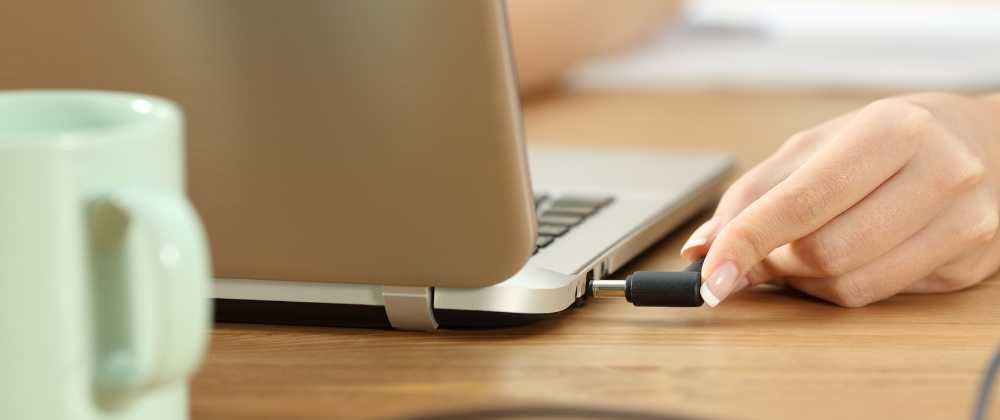We’ve all been there – you go to use your laptop without the charger plugged in and it refuses to turn on. You plug it in, and suddenly it springs to life. Annoying, right? If your older laptop is only working when connected to AC power, there are a few likely culprits behind the issue.
In this post, I’ll discuss some reasons why your laptop lacks enough juice to run on its battery alone, along with some solutions to consider.
Reason 1 – The battery is old and no longer holds a charge.
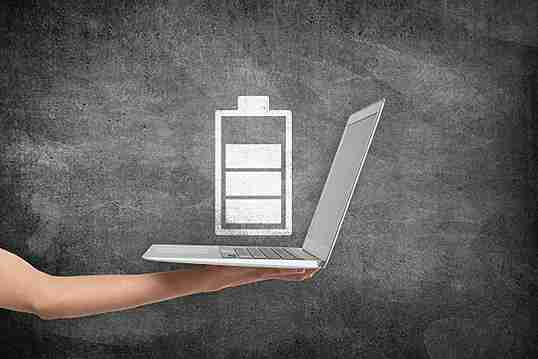
The most common reason an aging laptop won’t run without being plugged in is that the battery has degraded over time. Lithium-ion batteries slowly lose their ability to hold a charge as they undergo more charge cycles.
According to Battery University, a lithium-ion battery will typically retain 80% of its original capacity after 300-500 full discharge/charge cycles. My laptop is now 3 years old, so it’s likely the battery has degraded, can no longer hold enough power, and requires constant charging to keep the laptop powered on. Any fault in docking station may also restrict the laptop charging.
Over time or due to certain circumstances, they can become faulty:
- Natural Wear and Tear: All batteries have a specific life cycle, typically measured in charge cycles. After a certain number of cycles, the battery’s capacity to hold a charge diminishes. Eventually, it might not hold a charge at all, making the laptop reliant on direct power.
- Swelling: In some cases, batteries can swell due to a buildup of gases inside. This can be caused by overcharging, excessive heat, or manufacturing defects. A swollen battery can pose a risk of rupture or explosion and should be replaced immediately.
- Faulty Cells: A laptop battery contains multiple cells. If even one of these cells is defective, it can affect the entire battery’s performance and your laptop battery will drain fast.
- Loose or Damaged Connectors: The connectors that link the battery to the motherboard can become loose or corroded. This can prevent the battery from supplying power to the laptop. In some cases, Laptop light may also flash when plugged in to indicate the issue.
Reason 2 – There is an issue with the laptop’s power settings.
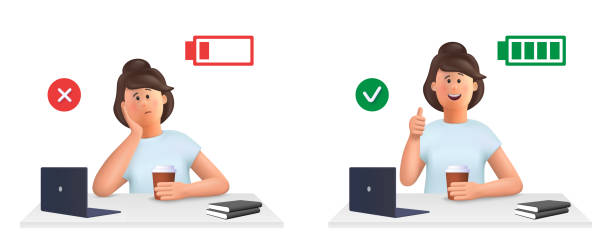
Every operating system, whether it’s Windows, macOS, or Linux, offers different power plans or power-saving settings. These plans are optimized for various uses and can determine how quickly a laptop goes to sleep, how brightly the screen shines, how hard the processor works, among other factors.
If these settings are misconfigured, it can lead to several issues:
- Instant Sleep or Shutdown: If the settings mistakenly dictate the laptop to sleep or shut down when on battery, it might give the impression that the laptop doesn’t work unless it’s plugged in.
- High Performance Mode: Some laptops have a ‘High Performance’ mode which demands more power, making the battery drain faster. If this mode is active, the laptop’s battery might drain too quickly when it’s not plugged in, making it seem like the laptop doesn’t work without power. But, the laptop charges quickly when shut down.
- Battery Conservation Mode: Some laptops, especially those designed for longevity, might have settings that stop the battery from charging beyond a certain percentage to extend its lifespan. This could make it seem as if the battery is not charging fully.
Reason 3 – The AC adapter is broken.
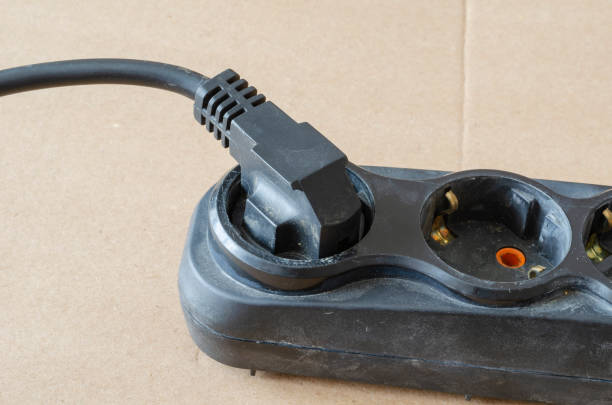
Finally, the AC power adapter (aka the laptop charger) may be malfunctioning. The adapter converts the wall outlet’s high voltage AC current into the lower DC voltage that charges the laptop’s battery. If it’s cracked, frayed, or otherwise defective, it won’t provide enough power to operate the laptop or charge the battery. Gradually, the laptop battery will drain out and the laptop will not turn on.
Try using a known good charger to see if the issue persists. If the laptop works fine with another charger, it’s likely yours needs to be replaced.
Reason 4 – Faulty Charging Port

The charging port on a laptop allows power from the AC adapter to reach the battery. If this port is damaged or faulty, the battery will not charge properly. Symptoms of a bad charging port include the laptop only working when plugged in, the battery not charging even when plugged in, or the charger falling out easily.
To fix this issue, you may need to replace the charging port or motherboard. A repair shop can diagnose the exact problem and perform the necessary repairs. Be careful not to wiggle or bend the charging cable excessively when plugged into a bad port, as this can damage the port further.
Reason 5 – Issues with the Motherboard or Other Related Components
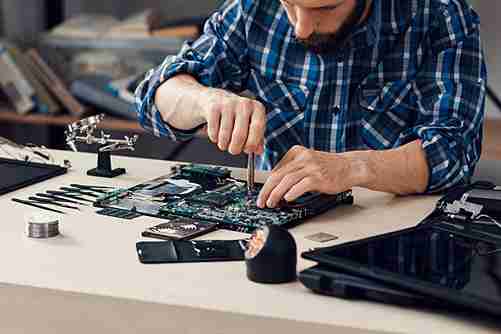

The motherboard is the central hub of a laptop, connecting all the essential components and ensuring they communicate effectively. If there’s an issue with the motherboard or related components, it can directly affect the laptop’s ability to function on battery power.
- Faulty Charging Circuits: The circuits responsible for managing the flow of electricity from the battery to the laptop might malfunction, preventing the device from utilizing battery power.
- Damaged Power Jack: The jack where the charger plugs in can become loose, bent, or corroded over time. If it’s not making a proper connection, the battery might not charge.
- Failed Power Management IC (Integrated Circuit): Modern laptops have ICs that manage power distribution. A faulty IC can prevent the laptop from switching between battery and direct power correctly.
- Corrosion or Short Circuits: Liquid spills or high humidity can cause corrosion on the motherboard. If the corrosion affects areas related to power management, it can lead to power issues.
- Firmware Issues: Sometimes, the firmware (embedded software on hardware components) that manages power distribution can become corrupt or outdated, causing power issues.
Reason 6 – Software Malfunctioning

If you have not upgraded the software updates in your laptop from so long, there are chances that the drivers are aged out. In this case, the laptop is forced to reject the AC adapter’s power. Update the battery driver to check if the laptop battery is able to hold the power. To update the battery drivers, follow the steps below:
- Press the Window + R keys together
- Type ‘devmgmt’ and locate the battery option and double click on it to expand
- Right click on Microsoft ACPI-complaint control Method Battery Device
- Uninstall the driver by clicking on the uninstall button.
- Restart your PC and download the latest driver.
Quick Fixes to Laptop Only Works When Plugged In
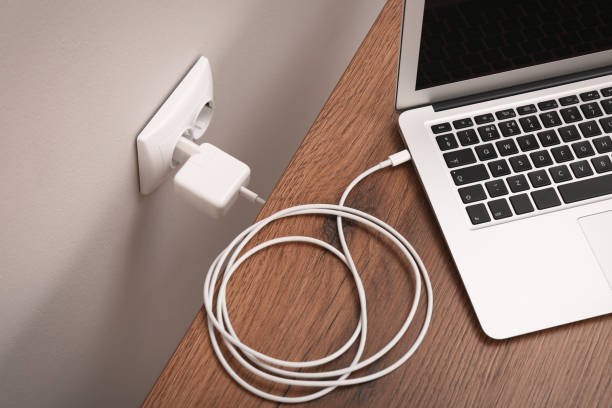
Here is a detailed list of all the possible fixes with step-by-step guides to fix a laptop that only works when plugged in:
Check the Battery’s Health
The health of a laptop’s battery is paramount in determining its efficiency and performance over time. As batteries age, their ability to hold a charge decreases. Thankfully, several tools, both built into operating systems and available as third-party applications, can help assess battery health.
1. Built-in Battery Health Check Tools
Most modern operating systems provide native tools that allow users to check the health and performance of their laptop batteries.
- Windows:
- Battery Report: Windows has a built-in feature that can generate a detailed battery report. To access this:
- Open the Command Prompt with administrative privileges.
- Type
powercfg /batteryreportand press Enter. - The system will generate a battery report in HTML format, usually saved in the user directory. You can open this file in a web browser to view details like battery capacity history, usage, and health.
- Battery Report: Windows has a built-in feature that can generate a detailed battery report. To access this:
- macOS:
- System Information: To check the battery’s condition on a Mac:
- Hold the Option key and click the Apple logo in the top-left corner.
- Select “System Information.”
- Under “Hardware,” select “Power.” Here, you can view the battery’s condition, cycle count, and other vital details. Typically, the condition is labeled as Normal, Replace Soon, Replace Now, or Service Battery.
- System Information: To check the battery’s condition on a Mac:
- Linux:
- UPower: Many Linux distributions come with the UPower tool.
- Open the terminal.
- Type
upower -i /org/freedesktop/UPower/devices/battery_BAT0and press Enter. Replace “BAT0” if your system uses a different identifier. - This command will provide details about the battery, including its health, state, and capacity.
- UPower: Many Linux distributions come with the UPower tool.
2. Third-party Applications and Software Recommendations
If you’re seeking more detailed insights or find built-in tools lacking, there are several reputable third-party applications designed to assess battery health.
- HWMonitor (Windows): This application provides a comprehensive overview of various hardware metrics, including battery health. It displays the current capacity of the battery relative to its original capacity, allowing users to gauge wear levels.
- BatteryCare (Windows): Specifically designed for laptop batteries, BatteryCare gives detailed information about the battery’s status and health. It also provides guidance on optimizing discharge cycles, which can extend battery life.
- CoconutBattery (macOS): This popular tool for Mac offers insights into your battery’s current charge, capacity relative to its original state, cycle counts, and more.
- Battery Monitor (Linux): Available for various Linux distributions, this tool offers a graphical interface to monitor battery health and status.
Hardware Solutions
When a laptop only functions when plugged in, or exhibits related power issues, the root cause often lies within the device’s hardware components. Understanding potential hardware solutions is pivotal in correctly diagnosing and fixing such problems. Let’s delve deeper into each solution:
1. Cleaning the Charging Port
The charging port, where the AC adapter connects to the laptop, can accumulate dirt, dust, or even oxidize over time. This can impede a proper connection and affect charging efficiency.
- Why Clean? Foreign particles or oxidation can act as insulators, preventing the efficient transfer of electrical current. A dirty port can lead to intermittent or no charging.
- How to Clean:
- Safety First: Always power down the laptop and disconnect it from any power source.
- Compressed Air: Use short bursts of compressed air to dislodge dust or debris from the port.
- Isopropyl Alcohol: For more stubborn residue or oxidation, dip a cotton swab in a bit of isopropyl alcohol (preferably 90% or higher) and gently clean the port. Ensure the laptop remains off until the alcohol has completely evaporated.
2. Checking and Replacing Internal Connectors
Internal connectors refer to the small components and cables inside the laptop that connect the battery and other hardware parts to the motherboard.
- Why Check? These connectors can become loose over time or due to physical shocks (like dropping the laptop). Corrosion or wear and tear can also affect their performance. A faulty connector can disrupt the power flow from the battery to the laptop.
- How to Check and Replace:
- Disassembly: Open the back panel of the laptop. This process varies by model, so it’s best to refer to a guide specific to your laptop.
- Visual Inspection: Look for any connectors that seem out of place, corroded, or damaged.
- Secure Connections: Gently ensure that connectors, especially those related to power, are firmly in place.
- Replacement: If a connector or cable appears damaged, it’s best to replace it. Some connectors can be purchased and replaced individually, while others might require the replacement of a larger component or assembly.
3. Motherboard Repair/Replacement Considerations
The motherboard is the central hub of a laptop, with almost every component connecting to it in some way. If it has defects or damage, especially in areas related to power management, significant issues can arise.
- Why Consider Repair/Replacement? Faulty charging circuits, damaged power management ICs, or other issues related directly to the motherboard might necessitate a repair or replacement.
- How to Approach:
- Diagnosis: Professional diagnosis is crucial. Some issues might be fixable without a full replacement.
- Repair vs. Replacement: Minor issues, like a faulty capacitor, might be repairable. However, extensive damage or multiple faults often make replacement more economical.
- Cost Consideration: Replacing a motherboard can be expensive. Depending on the laptop’s age and value, it might be worth considering purchasing a new laptop.
- Data Safety: If the motherboard is replaced, your data typically remains safe on your hard drive or SSD. However, always maintain regular backups in case of unforeseen complications.
Software and Settings Solutions
While hardware issues are often to blame for laptop power problems, it’s also possible for software configurations or outdated drivers to cause these concerns. Understanding the software and settings solutions can help diagnose and rectify such software-related issues.
Here’s a detailed breakdown:
1. Resetting Power Plans to Default
Every operating system (OS) comes with pre-defined power plans, which are sets of hardware and system settings that manage how your computer uses power. Users often customize these plans, or software installations might change them. If these are misconfigured, it could affect the laptop’s battery performance.
- Why Reset? Over time, with various software installations and updates, power settings might get changed or corrupted. Resetting brings everything back to a known good state as defined by the OS manufacturer.
- How to Reset:
- On Windows: Go to Control Panel > Power Options. Select your current power plan, click on “Change plan settings,” then “Restore default settings for this plan.”
- On macOS: System Preferences > Energy Saver, then restore settings as needed.
2. Updating Battery and Chipset Drivers
Drivers are software components that allow the OS and hardware to communicate effectively. Outdated or corrupt drivers can lead to hardware malfunctions, including those related to battery and power management.
- Why Update? Manufacturers periodically release driver updates to fix known issues, improve performance, or provide compatibility with newer OS versions. Keeping drivers updated ensures optimal hardware performance.
- How to Update:
- On Windows: Device Manager > Batteries > Right-click on “Microsoft ACPI-Compliant Control Method Battery” > Update Driver. Chipset drivers can typically be updated from the manufacturer’s website.
- On macOS: Apple delivers drivers as part of their OS updates, so simply ensuring your macOS is up-to-date should suffice.
3. Operating System Updates or Reinstallation
The OS is the backbone of your laptop, managing both software and hardware components. Over time, files can become corrupt, or issues might arise due to software conflicts. Keeping the OS updated or reinstalling it can address many power-related problems.
- Why Update or Reinstall? Updates often come with fixes for known issues, including those related to power management. If the system is too corrupted or bogged down with software conflicts, a fresh reinstallation can bring the laptop back to its original performance.
- How to Update or Reinstall:
- On Windows: For updates, go to Settings > Update & Security > Check for updates. For reinstallation, one can use the “Reset this PC” feature or boot from an installation media.
- On macOS: For updates, go to System Preferences > Software Update. For reinstallation, one can boot into macOS Recovery mode and choose “Reinstall macOS.”
Observe Charging Patterns
Laptops rely on battery power for portability, but over time, many users notice changes in how their device charges or maintains its charge. Observing these charging patterns is critical in diagnosing potential battery or hardware issues. Let’s break down the significance of each pattern and what it might indicate:
1. Does the Battery Charge to 100%?
Monitoring whether a battery can fully charge is essential. If a battery can’t reach 100%, it might indicate deterioration or other problems.
- Significance:
- Natural Wear and Tear: Over time and after many charge cycles, all batteries lose some of their capacity. If an older battery doesn’t charge fully, it may be nearing the end of its useful life.
- Faulty Cells: Modern batteries are made up of multiple cells. If one or more of these cells become defective, the battery might not charge fully or hold a charge efficiently.
- Software Calibration Issues: Sometimes, the software’s representation of the battery’s charge level becomes uncalibrated with the actual charge. In such cases, the battery might be fully charged even if the OS indicates otherwise.
- Troubleshooting:
- Battery Calibration: This process involves fully charging the battery, then letting it discharge completely, and then charging it again to recalibrate the software’s reading of the battery’s capacity.
- Inspect Battery Health: Use built-in tools or third-party applications to check the battery’s health, as previously discussed. If the battery is in poor health or has many charge cycles, consider replacement.
2. Rapid Draining When Unplugged
If a laptop battery discharges too quickly after being unplugged, it could point to various issues, both hardware-related and software-related.
- Significance:
- Battery Deterioration: A battery that has degraded over time will not hold its charge as efficiently as when it was new.
- High-Performance Demands: Running resource-intensive applications, having high screen brightness, or using high-performance power plans can cause faster battery drainage.
- Background Processes: Sometimes, background applications or processes can use a significant amount of power, leading to rapid battery drainage.
- Faulty Hardware or Software: Hardware components malfunctioning or software conflicts can lead to increased power consumption.
- Troubleshooting:
- Energy Consumption Check: Both Windows and macOS have built-in tools that can show which applications or processes are consuming the most energy.
- Adjust Power Settings: Ensure the laptop is set to a balanced or power-saving mode when unplugged.
- Update Software: Ensure your operating system and drivers are updated. Sometimes, software updates fix known issues that might be causing increased power consumption.
- Hardware Check: If software solutions don’t remedy the rapid drainage, consider having the laptop checked for faulty hardware components.
Following troubleshooting steps like these can help isolate the cause and fix a laptop that only works when plugged into power. Determine if it’s a software issue like power settings or drivers, battery connections, or if the battery itself is bad and needs replacement.
Frequently Asked Questions
Here are some frequently asked questions (FAQs) about laptops only working when plugged in:
Q1: Why is my laptop only working when plugged in but not charging?
A: This is usually caused by a faulty charging cable, failing battery, or software issue preventing charging. Try replacing the cable, battery, and updating drivers to fix it.
Q2: How do I fix my laptop not working unless I plug it in?
A: Remove the battery, hold the start button for 15 secs to drain power, then replace battery and see if it will charge/run plugged in. Check the outlet with another device.
Q3: Why does my laptop shut down when I unplug the charger?
A: If power settings are incorrectly changed, it may shut down when unplugging. Check settings like low battery percent and low battery action. Reset to default if needed.
Q4: Why does my laptop battery say 100% but dies when unplugged?
A: The battery likely needs to be recalibrated after prolonged use to sync the reported charge with actual runtime. Drain and recharge a few times to recalibrate it.
Q5: How do I force a dead laptop battery to charge?
A: Remove the battery, hold the power button for 10 secs to drain power, then replace battery and plug in the charger to see if it will charge again.
Q6: Can a laptop run on AC power only?
A: Yes, a laptop can run only on AC power indefinitely. However, this is bad for the battery’s health long-term and should be avoided if possible.
